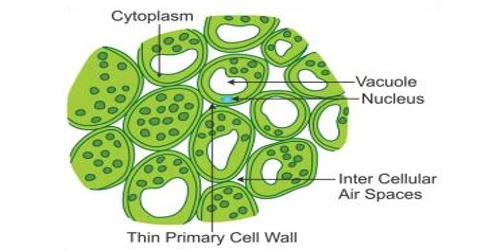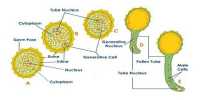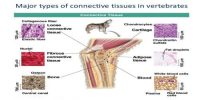Position: Parenchyma tissue occupies the major parts of various plant organs such as- Pith, mesophyll of leaves, cortex, etc. It is a type of simple permanent tissue that makes a major part of ground tissues in plants, where other tissues like vascular tissues are embedded.
Structure:
- It is a living cell and it has a prominent nucleus and protoplast
- Round, oval or polygonal in shape.
- Generally, intercellular space is present.
- These cells are tightly packed or may have small intercellular space
- If the cells of this tissue contain chloroplast, it’s called chlorenchyma
- They are made up of thin cell wall made up of cellulose, hemicellulose
- Mesophyll of leaves is composed of chlorenchyma.
- Storage parenchyma cells may have thick xyloglucan walls e.g. in the endosperm of the date palm. The sugar is used during germination and walls become thin.
- Parenchyma cells may have a thick lignified wall that makes it difficult to differentiate it from sclerenchyma
- The chloroplast is present in the parenchyma cells that are specified to perform photosynthesis

The main characteristics of parenchyma are:
- They are living permanent tissues that have the ability to divide at maturity and help in the regeneration and healing of wounds
- Single parenchyma cell of a zygote has an ability to develop into an entire plant. These cells are called “totipotent” cells
- Parenchyma cells occur in the form of continuous masses as homogeneous parenchyma tissues e.g. in pith and cortex of stems and roots, mesophyll of leaves, the flesh of succulent fruits and in the endosperm of seeds
- Parenchyma cells are essential for activities like photosynthesis, storage, secretion, assimilation, respiration, excretion and radial transport of water and solute
Function:
In plants, parenchymal cells with thin cell walls and the ability to reproduce fulfill functions including: Photosynthesis, Gas exchange, Food storage, Wound repair and new growth, Secretion of sap, etc. Some other functions are –
(i) To store, manufacture, and conduct food materials.
(ii) If it is present in the epidermis, it may be defensive in function.
In animals, “parenchymal” cells refer to the functional cells in every organ. That means that almost every function performed in an animal’s body is performed by parenchymal cells. There are too many of these functions to count in total, but some examples are:
- Perception, thinking, information storage and processing (nervous system)
- Gas exchange (lungs)
- Producing immune cells (lymphatic system)
- Filtering blood (kidneys)
- Breaking down toxins (liver)
They are non-vascular and composed of simple, living, and undifferentiated cells, which are modified to perform various functions.














